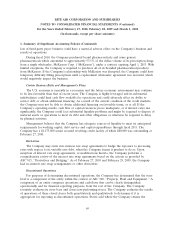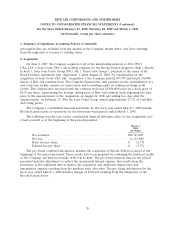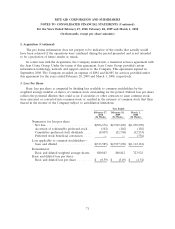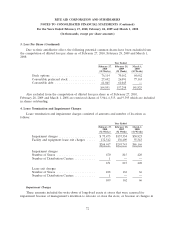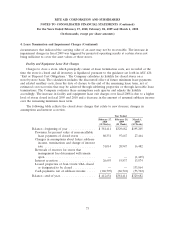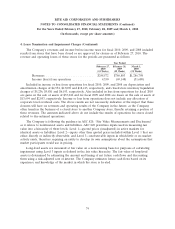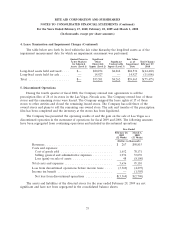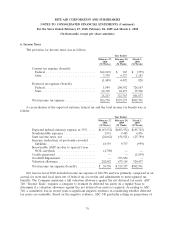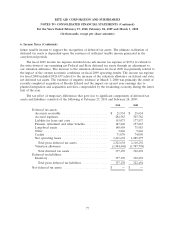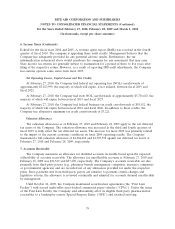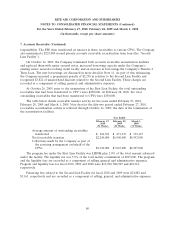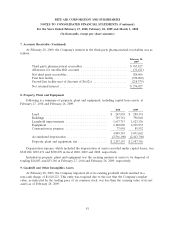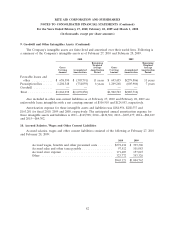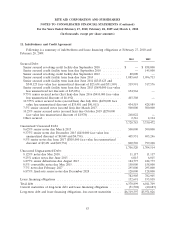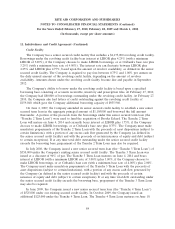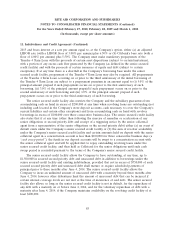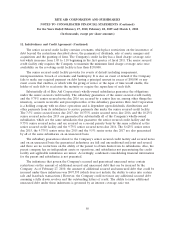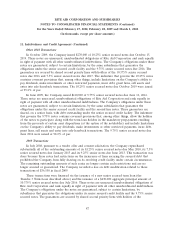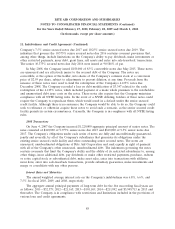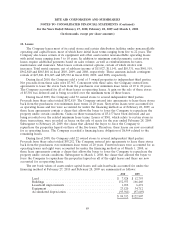Rite Aid 2010 Annual Report Download - page 79
Download and view the complete annual report
Please find page 79 of the 2010 Rite Aid annual report below. You can navigate through the pages in the report by either clicking on the pages listed below, or by using the keyword search tool below to find specific information within the annual report.RITE AID CORPORATION AND SUBSIDIARIES
NOTES TO CONSOLIDATED FINANCIAL STATEMENTS (Continued)
For the Years Ended February 27, 2010, February 28, 2009 and March 1, 2008
(In thousands, except per share amounts)
6. Income Taxes (Continued)
Eckerd for the fiscal years 2004 and 2005. A revenue agent report (RAR) was received in the fourth
quarter of fiscal 2010. The company is appealing these audit results. Management believes that the
Company has adequately provided for any potential adverse results. Furthermore, the tax
indemnification referenced above would reimburse the company for any assessment that may arise.
State income tax returns are generally subject to examination for a period of three to five years after
filing of the respective return. However, as a result of reporting IRS audit adjustments, the Company
has statutes open in some states from fiscal 2003.
Net Operating Losses, Capital Losses and Tax Credits
At February 27, 2010, the Company had federal net operating loss (NOL) carryforwards of
approximately $3,423,999, the majority of which will expire, if not utilized, between fiscal 2019 and
fiscal 2022.
At February 27, 2010, the Company had state NOL carryforwards of approximately $5,736,643, the
majority of which will expire between fiscal 2019 and fiscal 2027.
At February 27, 2010, the Company had federal business tax credit carryforwards of $58,152, the
majority of which will expire between fiscal 2012 and fiscal 2020. In addition to these credits, the
Company has alternative minimum tax credit carryforwards of $3,221.
Valuation Allowances
The valuation allowances as of February 27, 2010 and February 28, 2009 apply to the net deferred
tax assets of the Company. The valuation allowance was increased in the third and fourth quarters of
fiscal 2009 to fully offset the net deferred tax assets. The increase for fiscal 2009 was primarily related
to the impact of the current economic conditions on fiscal 2009 operating results. The Company
maintained a full valuation allowance of $1,984,468 and $1,787,798 against net deferred tax assets at
February 27, 2010 and February 28, 2009, respectively.
7. Accounts Receivable
The Company maintains an allowance for doubtful accounts receivable based upon the expected
collectibility of accounts receivable. The allowance for uncollectible accounts at February 27, 2010 and
February 28, 2009 was $31,549 and $37,490, respectively. The Company’s accounts receivable are due
primarily from third-party payors (e.g., pharmacy benefit management companies, insurance companies
or governmental agencies) and are recorded net of any allowances provided for under the respective
plans. Since payments due from third-party payors are sensitive to payment criteria changes and
legislative actions, the allowance is reviewed continually and adjusted for accounts deemed uncollectible
by management.
Until October 26, 2009, the Company maintained securitization agreements (the ‘‘First Lien
Facility’’) with several multi-seller asset-backed commercial paper vehicles (‘‘CPVs’’). Under the terms
of the First Lien Facility, the Company sold substantially all of its eligible third party pharmaceutical
receivables to a bankruptcy remote Special Purpose Entity (‘‘SPE’’) and retained servicing
79


